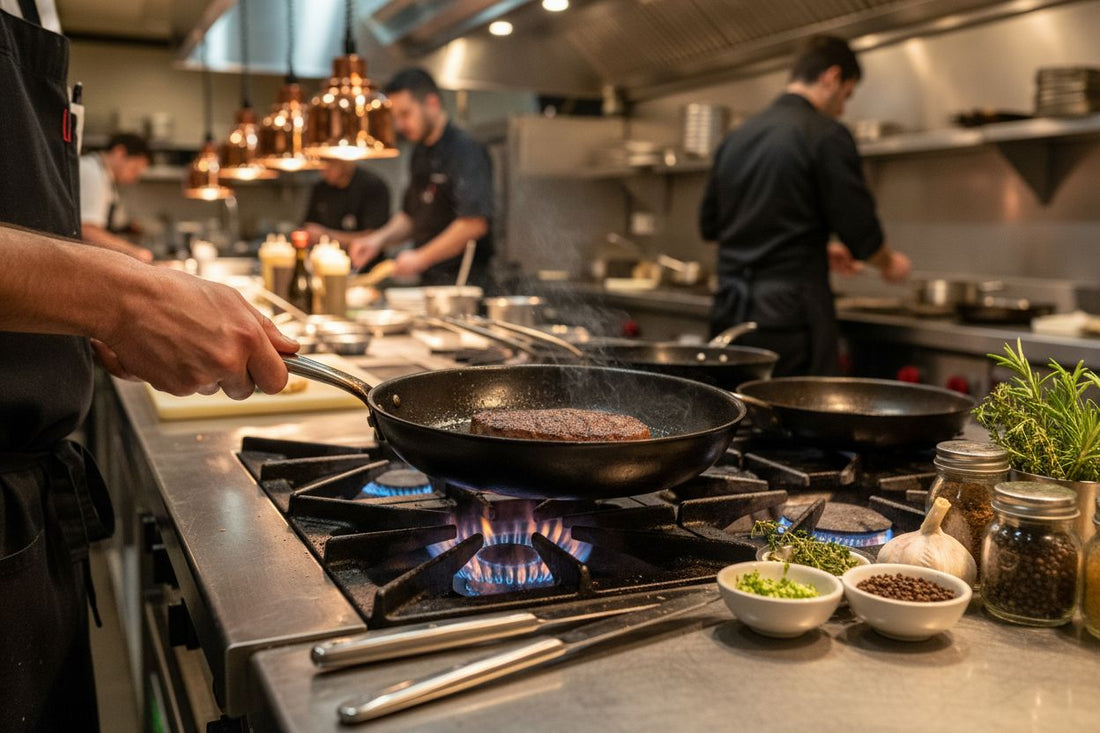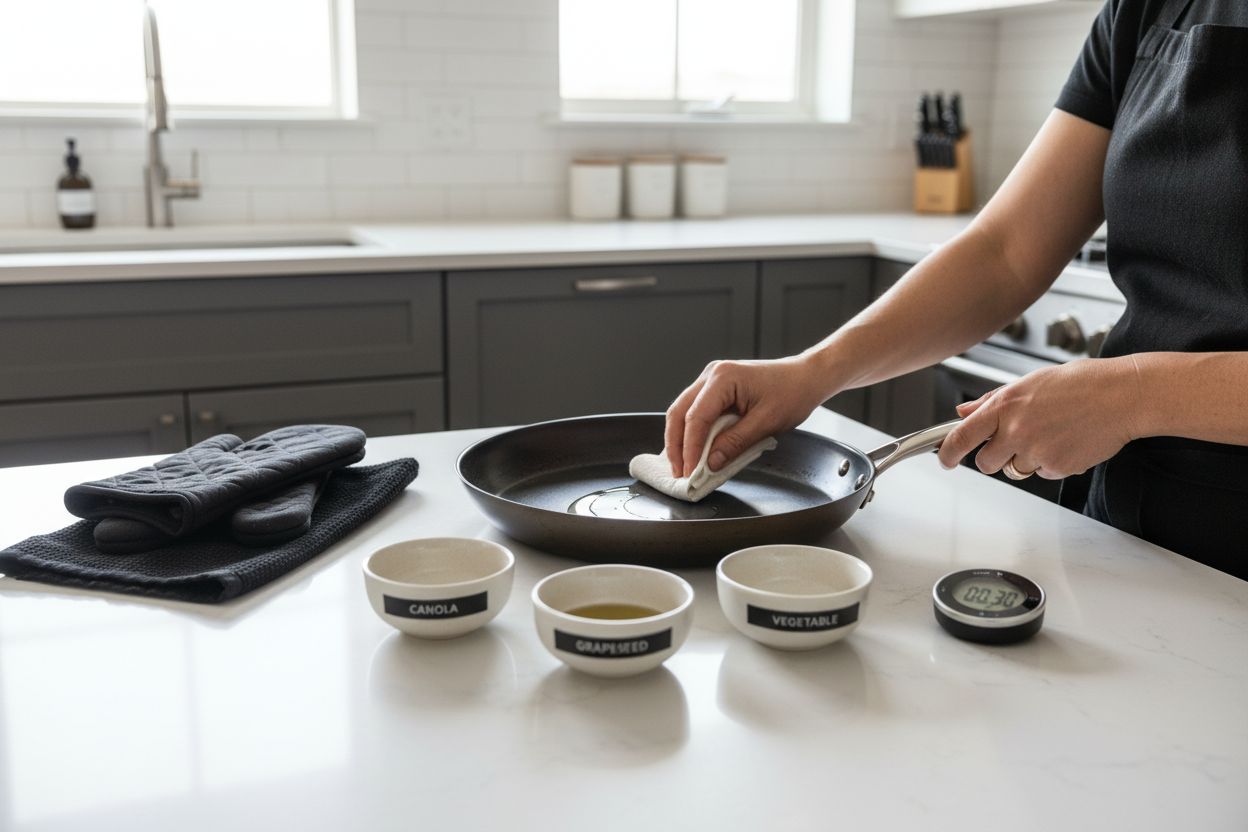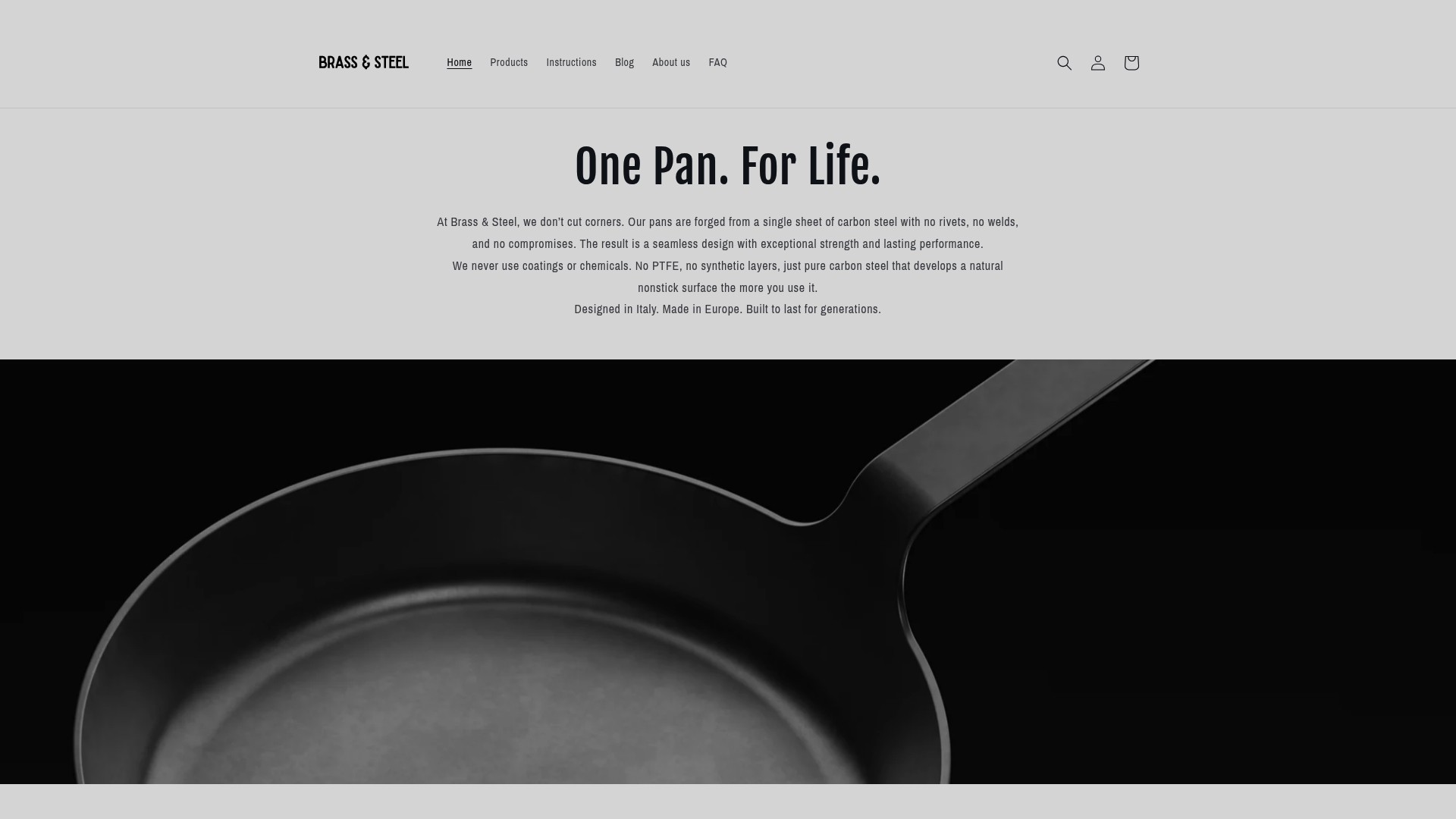
How Carbon Steel Pans Develop Patina: Complete Guide
Share
Did you know that a well-seasoned carbon steel pan can become nearly as nonstick as modern synthetic cookware? This remarkable transformation begins with a thin, dark layer called patina, which forms as oil bonds to the metal each time you cook. Understanding how patina develops not only protects your pan from rust but also improves every meal you make. Investing a little time in building this coating can mean years of easy, flavorful cooking.
Key Takeaways
| Point | Details |
|---|---|
| Patina Formation | A patina develops through the polymerization of thin oil layers on heated carbon steel pans, enhancing their nonstick properties. |
| Seasoning Process | Proper seasoning involves cleaning the pan, applying high-smoke-point oil, and heating to create a durable protective layer. |
| Cooking Benefits | A well-seasoned patina enhances food release, improves heat distribution, and protects against rust and corrosion. |
| Common Mistakes | Avoid thick oil layers, overheating, and harsh cleaning methods to maintain a stable patina and optimal cooking performance. |
Table of Contents
- What Is Patina On Carbon Steel Pans
- The Science Behind Patina Formation
- How To Season Carbon Steel Pans
- Impact Of Patina On Nonstick Performance
- Common Pitfalls And How To Avoid Them
What Is Patina On Carbon Steel Pans
A patina is far more than just a layer on your carbon steel pan. It’s a culinary transformation that turns a plain metal surface into a cooking masterpiece. According to research from Wikipedia’s Cookware Seasoning Guide), patina emerges through a careful process of layering thin oils and oxidizing them with heat, creating a protective and increasingly nonstick surface.
Think of patina like a fine wine that gets better with age. As you cook, the pan develops a dark, smooth coating that does several incredible things:
- Protects the underlying metal from rust and corrosion
- Creates a naturally nonstick cooking surface
- Enhances the pan’s heat distribution and retention
- Prevents food from sticking during high-temperature cooking
The patina formation is essentially a chemical dance between oil, metal, and heat. When you repeatedly season your carbon steel pan by applying a thin layer of high-smoke-point oil and heating it, the oil polymerizes—transforming from a liquid into a hard, plastic-like coating that bonds directly with the pan’s surface. Learn more about mastering carbon steel pan seasoning to create the perfect patina.
Every meal you cook contributes to this remarkable process. Fatty foods, searing techniques, and consistent care gradually build a rich, dark patina that not only protects your pan but also imparts a subtle depth of flavor to your cooking. It’s like your pan is telling the story of every delicious meal you’ve prepared.
The Science Behind Patina Formation
Understanding patina formation is like unlocking a culinary chemistry secret. According to research from Wikipedia’s Cookware Seasoning Guide), the process involves complex molecular transformations where thin layers of oil undergo polymerization when exposed to high temperatures.
Here’s what happens during this fascinating scientific process:
- Oils applied to the pan begin to break down molecularly
- Heat causes these oil molecules to oxidize and rearrange
- The oxidized molecules form tight, interconnected polymer chains
- These chains create a hard, plastic-like protective film
The chemical reaction is precise and deliberate. As oils heat up, their molecular structure changes dramatically—transforming from a liquid state into a durable, adherent coating that bonds directly with the carbon steel’s surface. Discover more about maintaining your pan’s seasoning to ensure optimal patina development.
Without proper seasoning, carbon steel remains vulnerable to rust and inconsistent cooking performance. The polymerized layer not only prevents corrosion but also creates a naturally nonstick surface that improves with each cooking session. It’s a remarkable example of how understanding material science can elevate your culinary experience.
How To Season Carbon Steel Pans
Seasoning a carbon steel pan is like creating a culinary masterpiece—it’s an art form that transforms a bare metal surface into a cooking marvel. According to MasterClass cooking techniques, the process requires precision and patience to develop that perfect protective layer.
Here’s a step-by-step guide to seasoning your carbon steel pan:
- Clean the pan thoroughly with hot water and mild soap
- Dry completely using a clean towel or low heat
- Select a high-smoke-point oil like:
- Canola oil
- Vegetable oil
- Grapeseed oil
Pro Tip: Avoid olive oil or butter, as they can create uneven seasoning and burn quickly.
As recommended by Serious Eats, the key is applying a minimal, ultra-thin oil layer. Use a paper towel to spread oil so thinly that the pan almost looks dry. Check out our comprehensive guide on carbon steel pan seasoning for more detailed instructions.
Heat the pan on medium-high until the oil starts smoking, which typically takes about 10 minutes. This process polymerizes the oil, creating a hard, protective coating. Repeat this oiling and heating process 3-4 times to build a deep, dark patina that will make your pan naturally nonstick and rust-resistant.
 Remember, a well-seasoned pan is like a trusted kitchen companion that only gets better with time.
Remember, a well-seasoned pan is like a trusted kitchen companion that only gets better with time.
Impact Of Patina On Nonstick Performance
A well-developed patina transforms your carbon steel pan from a basic cooking surface into a culinary powerhouse. According to research from Serious Eats, a properly seasoned pan can rival modern nonstick coatings in performance, delivering remarkable food release and cooking capabilities.
Key nonstick performance benefits of a mature patina include:
- Reduces food sticking dramatically
- Enhances browning and Maillard reactions
- Creates a naturally protective cooking surface
- Improves overall heat distribution
- Prevents rust and metal corrosion
Professional Tip: The more you cook, the better your pan’s nonstick properties become.
As highlighted in Wikipedia’s Cookware Research, the polymerized layer acts like a microscopic barrier between your food and the pan’s metal surface. Learn more about nonstick alternatives and safe cookware options to understand why carbon steel is becoming a chef’s preferred choice.
Unlike chemical nonstick coatings that degrade over time, a carbon steel pan’s patina actually improves with proper care.
Each cooking session adds another micro-layer to your pan’s protective coating, making it more nonstick and more resilient. Think of it as your pan developing its own culinary personality—unique, robust, and constantly improving.
Common Pitfalls And How To Avoid Them
Developing a perfect patina isn’t without its challenges. According to research from Blanc Creatives, there are several critical mistakes that can derail your carbon steel pan’s seasoning journey.
Key pitfalls to watch out for:
Here’s a comparison of patina formation, key benefits, and common pitfalls:
| Aspect | Patina Benefits | Common Pitfalls |
|---|---|---|
| Nonstick Performance | Improved food release Natural nonstick surface |
Sticky patches from thick oil Reduced release if damaged |
| Protection | Rust and corrosion resistance Durable barrier |
Vulnerable to rust if not seasoned Coating may flake if not built up |
![]() | Cooking Quality | Even heat distribution
| Cooking Quality | Even heat distribution
Enhanced browning | Uneven seasoning weakens results
Poor heat retention if damaged |
| Seasoning Method | Thin oil layers
High heat polymerisation | Overheating oil
Using low smoke point oils |
| Care Advice | Gentle cleaning
Regular oiling | Harsh detergents
Prolonged soaking |
- Overheating oil to the point of burning
- Using acidic foods too early in seasoning
- Applying excessively thick oil layers
- Cleaning with harsh detergents
- Soaking the pan for extended periods
Warning: A single mistake can strip away months of careful seasoning work.
As highlighted in Wikipedia’s Seasoning Guide), the most common error is applying oil too thickly. When oil is not wiped down to an ultra-thin layer, it creates sticky, uneven patches that compromise your pan’s nonstick performance. Explore our comprehensive guide on maintaining carbon steel cookware to prevent these common mistakes.
The secret is patience and precision. Avoid cooking acidic tomato sauces or deglazing with wine until your pan has developed a robust patina. Always use gentle cleaning methods, dry immediately after washing, and apply a light layer of oil after each use. Think of your carbon steel pan like a fine musical instrument—it requires gentle, consistent care to perform at its best.
Turn Your Patina Knowledge Into Lasting Kitchen Results
Struggling to build that enviable, even patina on your carbon steel pan? You are not alone. Many cooks deal with rust, sticking food, or uneven seasoning. The good news is that with the right techniques and the right pan, you can develop a naturally nonstick surface that actually improves over time. Expertly made pans like those in our Carbon Steel Collection unlock the potential for a rich and protective patina, pairing science with long-lasting performance.

Ready to create cookware that tells your cooking story? Do not let seasoning struggles hold you back from a seamless kitchen experience. Discover how heirloom-quality carbon steel pans, forged in one piece without rivets, make patina development easier and more reliable. Visit Brass & Steel today and take the first step toward cookware that only gets better with every meal. Start now and feel the difference in your next dish.
Frequently Asked Questions
How does patina form on carbon steel pans?
Patina forms on carbon steel pans through a process of seasoning, where thin layers of oil are applied and heated. This process causes the oil to polymerize, creating a protective and nonstick surface on the pan.
What are the benefits of a well-developed patina?
A well-developed patina improves nonstick performance, protects against rust and corrosion, enhances heat distribution, and prevents food from sticking during cooking. It can also add a subtle depth of flavor to your meals.
What common mistakes should I avoid when seasoning my carbon steel pan?
Common mistakes include applying oil too thickly, overheating the oil, using acidic foods too early, cleaning with harsh detergents, and prolonged soaking of the pan. These can compromise the nonstick performance and overall seasoning.
How often should I season my carbon steel pan for optimal patina development?
You should season your carbon steel pan regularly, especially after deep cleaning. A good practice is to apply a light layer of oil after each use to maintain and improve the patina over time.